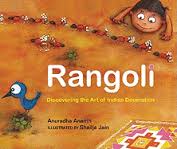
Every morning Ajji’s village is decorated with rangolis – special patterns made usually from rice flour and sugar or materials such as cereals, pulses, grains, sand or beads. Dots, lines, flower designs, on the ground on the wall, everywhere. Food for ants, beautiful to look at and fun for birds, dogs and children. This delightful book makes a wonderful introduction to the art of rangoli and the illustrations carry the exuberance of these earthy patterns.The book includes a spread at the back on how to make your own rangolis. Rangoli is one of the most popular art forms in India. It is also known in different parts of the country as muggu, kolam and alpona. The motifs used are usually taken from nature or geometric patterns. Rangolis are particular popular around festivals such as diwali – the Hindu festival of light.
- ISBN: 9781847801791
- Author: Ananth, Anuradha
- Illustrator: Jain, Shailja
- Published: 2011 , Frances Lincoln Ltd
- Themes: art, Festivals, patterns
- Descriptors: Asia, Early Years (ages 2-6), India, Picture Book, Realistic Fiction
- No. of pages: 20

I am from India and I grew up with Rangoli. It is not an easy design that anyone can learn. The intricate designs are culture bound and can be drawn, painted, or done using flower petals like my mothers beautiful lotus Rangoli. Kolum, as it is called by Tamil speaking people, is a tradition that has been in vogue for many years. The Iyengar families from south India usually draw four lines on either sides of the threshold (entrance to the house/doorway). I am still fascinated with the amazing designs some women can create. The temple entrances,arangetram (dance debut) venues, wedding halls, etc are usually decorated with this intricate art form that originated in India.